Tony Hardy’s Murder Flat - Camden Town, London
January 2002, ‘Camden Ripper’ Anthony Hardy came to the attention of the police after an upstairs neighbour complained that he had vandalised her door with spraypaint.Hardy had left a trail of paint back to his flat, and police quickly arrived. Behind a locked door inside they discovered the dead body of a woman lying on his bed. Hardy claimed he had no idea how she got to be there, due to his alcoholism, and claimed she must have had a heart attack. Surprisingly, a pathologist, who would later be fired for incompetence, agreed, and Hardy was free to go.
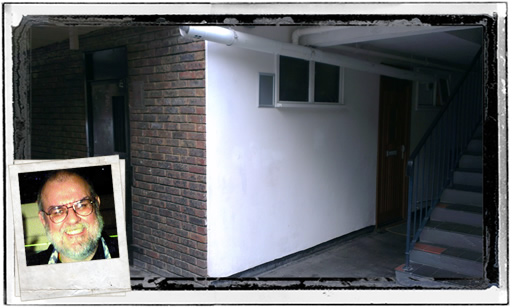
During his arrest he managed to knock one policeman unconscious, and stabbed another through his hand and eye socket. Damning evidence was found inside the flat, along with bloodstains where he had mutilated and dismembered his victims.
He went on trial in November 2003 and pled guilty to the murders of three women, including the one found in his flat a year before. He was sentenced to spend the rest of his natural life in prison, and is suspected to have killed up to six more victims.
135 Wardour Street – Soho, London
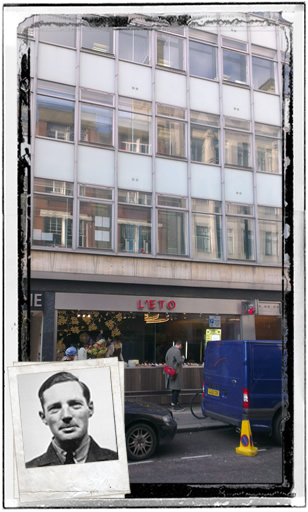 On the 10th of February 1942, the body of 35-year old Evelyn Oatley was found naked and mutilated in the upstairs flat here. She'd been strangled and had had her throat cut by 28-year old 'Blackout Ripper' Gordon Cummins, who had broken into the flat, killed her and then mutilated her body with a tin opener he found at the scene, then left behind with his fingerprints on it. Cummins would take advantage of the night time 'blackout' conditions during the air raids of WW2 to commit his murders in what would be a six-day murder spree in the West End.
On the 10th of February 1942, the body of 35-year old Evelyn Oatley was found naked and mutilated in the upstairs flat here. She'd been strangled and had had her throat cut by 28-year old 'Blackout Ripper' Gordon Cummins, who had broken into the flat, killed her and then mutilated her body with a tin opener he found at the scene, then left behind with his fingerprints on it. Cummins would take advantage of the night time 'blackout' conditions during the air raids of WW2 to commit his murders in what would be a six-day murder spree in the West End.
He was arrested shortly afterwards on the 16th, having committed four more attacks (two murders) in the time since, and went on trial at the Old Bailey that April. The trial lasted only one day, he was convicted of four murders (but suspected of six) and was sentenced to death. He was executed by Albert Pierrepoint by Wandsworth prison on the 26th June that year...ironically, during an air raid.
The original building no longer stands, but many of the houses still standing on Wardour Street are Victorian.
The Phoenix – Milwaukee, Wisconsin, United States
The red building in the middle of this photograph used to be a gay bar called The Phoenix, and stands at 232s 2nd St., Milwaukee, Wisconsin.
On March 24th, 1988 Jeffrey Dahmer met 22-year old Richard Guerrero here, and lured him back to his grandmother’s house with the promise of money.
Once there, he drugged him with sleeping pills, strangled him with a leather strap, had sex with his corpse and dismembered him. Dahmer dumped his dismembered body parts in the trash, and though they were discovered less than 24 hours later, police were not able to tell who had killed him.

Dahmer’s grandmother soon told him to leave and find his own place, both because of his habits of bringing strange men back late at night and the foul smells she had noticed coming from the basement and the garage.
It had been his fourth murder, and he kept Guerrero’s skull as a trophy. In his later murders, he would build an altar inside his own apartment with a collection of the bones and skulls of his victims.
He was arrested in June 1991 when, after handcuffing his next intended victim, the man had managed to break free and flee from the apartment. He returned with police, who found a large knife and a collection of polaroid photographs, that Dahmer had taken himself, of various bodies inside the property that he had been dissecting. Body parts were found inside his fridge and the apartment was filled with evidence.
He confessed to seventeen murders, and was handed sixteen life sentences. He was later murdered himself, in November 1994, by fellow inmate Christopher Scarver.
Photograph courtesy of Angie Moser
Israel Lipski’s House – Batty Street, Whitechapel, London
On the first floor of the house first on the left in this photograph, on the 28th June 1887, in a truly bizarre offence 22-year old Israel Lipski murdered fellow lodger Miriam Angel. It was a sensation at the time, and received widespread media attention.
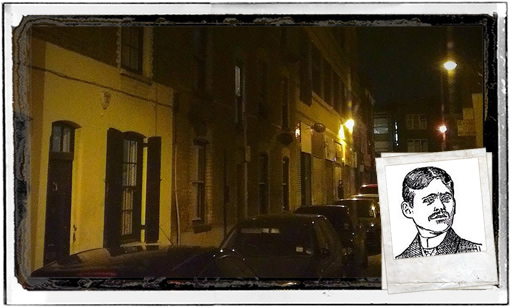
Lipski had started his own business making walking sticks and umbrellas, and the morning of the murder was supposed to have been his first day in business. With his new employees waiting for him in the attic, ready to begin work, Lipski left the house and went to a local shop to buy chemicals they would need that morning.
He returned to the house with a vial of nitric acid, but did not go up to meet the men in the attic. For whatever reason he chose that moment to instead enter the front room of the first floor, where Miriam Angel lay alone in bed, her husband having left for work earlier that morning.
She was beaten and sexually assaulted, before Lipski forced the acid down her throat and killed her. He then attempted to kill himself by drinking what remained, and would seem to have climbed under her bed, where he was then found by surprised detectives who were quickly called to the scene, after horrified lodgers made the discovery on the first floor. Lipski’s new employees, in the meantime, had been waiting patiently for him on the top floor and had no idea what was going on.
Lipski survived, was taken to hospital and made a full recovery. He was charged with murder, but claimed that his employees had in fact killed Miriam and attempted to kill too. He was quickly deemed to be guilty, however, and the case received heavy publicity. Many believed him to be innocent, and demanded his sentence was overturned. He allegedly confessed to a rabbi on the day before his execution, and was hanged on the 21st August 1887, in the yard of Newgate Prison, by notorious Victorian hangman James Berry.
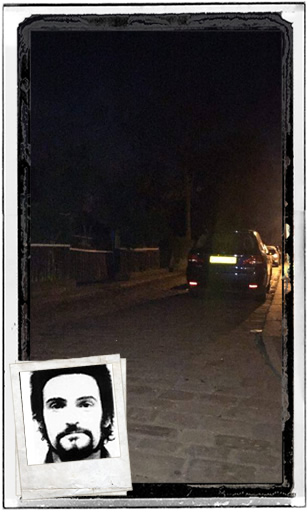
Southfield Square, Bradford
On the 21st of January 1978, 22-year old Yvonne Pearson was standing on this corner when 'Yorkshire Ripper' Peter Sutcliffe picked her up in his car.
He drove her to a nearby piece of waste ground, and as she got out of the car hit her several times about the head with a hammer. Another car then appeared as he was committing his crime, so Sutcliffe pulled her body behind an old sofa that was lying nearby, pulled the stuffing from inside it and forced into her mouth to keep her quiet, and waited for the driver to leave. When the car eventually left he beat Pearson to death, threw dirt over her body, hid her crudely beneath the sofa and fled.
She wasn't found until two months later. A passer-by spotted an arm sticking out from underneath and, thinking it was a tailor's dummy, approached, and made the discovery that it was in fact the body of a woman.
Sutcliffe wasn't arrested until until three years later, and when asked about Yvonne's murder claimed that he had been heading home, and had met her entirely by chance after being forced to stop at that particular junction when a car had pulled out in front of him. He claimed that the voice of God had told him to kill prostitutes, was sentenced to twenty concurrent life sentences for 13 murders, as is currently held at Broadmoor high-security Psychiatric Hospital.
Photo courtesy of Ricky Cobb.
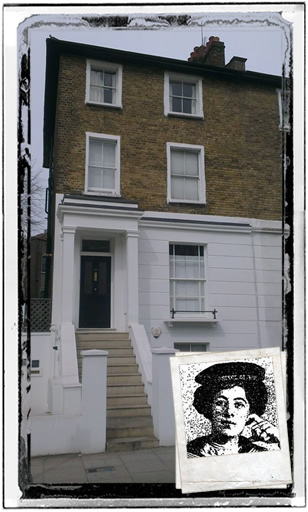 The Camden Town Murder House
The Camden Town Murder House
On the 11th September 1907 an unknown man returned to this house on Agar Grove with 23-year old Emily Dimmock, and into her bedroom on the first floor. He had sex with her, and then when she fell asleep cut her throat open with a razor blade and killed her. He then ransacked the house, stole a small amount of her jewellery, and simply strolled out the front door.
She was then found later that day by her boyfriend when he returned to the house, lying naked on the bed and soaked in blood. When police arrived, they realised the jewellery was missing, and as she had no injuries other than the wound to her throat originally concluded that robbery must have been the motive.
A man named Robert Wood was later arrested and tried for her murder, but after retiring for only fifteen-minutes, on the recommendation of the judge, the jury found Wood to be not guilty. It was a sensation at the time, and whoever the killer was he was never caught.
Mitre Square, Aldgate
One of the most notorious murder spots in all of true crime, Catherine Eddowes was killed here by the unknown man known as 'Jack the Ripper'. The murder took place in the corner opposite the camera. The flower bed in the photograph used to be a housing block at the time, and the pathway in the corner it was not there.
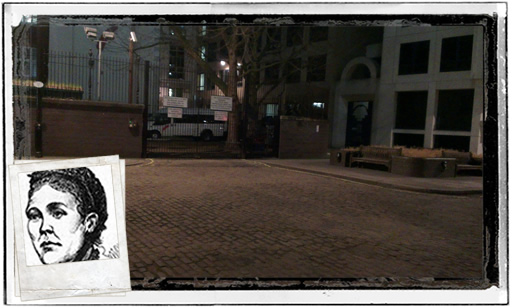 It was the 30th of September 1888, a Saturday night, but being well into the early hours, after a night of poor weather the surrounding area was deserted.
It was the 30th of September 1888, a Saturday night, but being well into the early hours, after a night of poor weather the surrounding area was deserted.
Her shockingly mutilated body was found at 01:45am by PC Edward Watkins, of the City of London police. It was the killer's second murder of the previous 45 minutes, 44-year old Elizabeth Stride having been found at 01:00am on nearby Berner Street.
Three men had seen Catherine talking with a man by the entrance to the square only minutes before she was found, but whoever he was he was never identified. To the left of the camera, a nightwatchman had been inside a warehouse, behind an open door the entire time and failed to hear anything. PC Richard Pearce, who lived at number 3 in the square (to the right of the camera), also heard nothing as the murder took place in full view of his bedroom window.
113, Williamsburg Village Apartments - Gainesville, Florida
On August 23rd, 1990, 36-year old 'Gainesville Ripper' Danny Rolling let himself into this townhouse through the unlocked back door, and entered apartment 113. Inside he found 17-year old Christina Powell asleep on the downstairs couch, but left her where she was to explore the rooms upstairs. In the bedroom he found 18-year old Sonja Larson asleep, taped her mouth shut with electrical tape and stabbed her to death. He then had sex with her body, mutilated her and returned downstairs to find Powell.
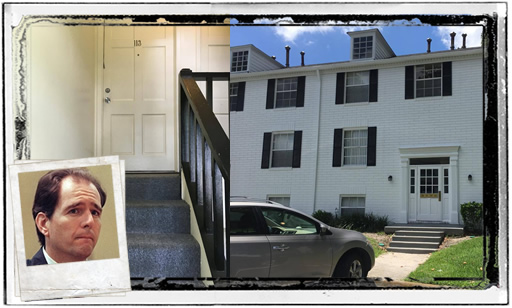 As with Larson he taped her mouth shut, then tied her hands behind her back.Threatening her with a hunting knife, he then raped her on the floor and stabbed her five times in the back, before mutilating her body and fleeing. When police arrived, they found that Rolling had posed both of his victims in sexually provocative positions for them to find.
As with Larson he taped her mouth shut, then tied her hands behind her back.Threatening her with a hunting knife, he then raped her on the floor and stabbed her five times in the back, before mutilating her body and fleeing. When police arrived, they found that Rolling had posed both of his victims in sexually provocative positions for them to find.
The double murder brought his number of victims to five, having previously committed a triple murder the year before. He would commit three more murders, including one in which he decapitated and disembowelled his victim, and posed her sitting upright on the bed with her head looking back towards her from a bookcase.
He was arrested in November 1991 on a burglary charge, and police found that his tools he was carrying matched those used to break into the victims' apartments. He told police that his motive was to be a 'superstar' like Ted Bundy, and it emerged that he had been living in a camp in the nearby woods when he committed the murders. He pleaded guilty to all charges, was sentenced to death, and was executed by lethal injection in Florida State Prison on October 25th, 2006.
Photograph courtesy of Rachel Tursky.
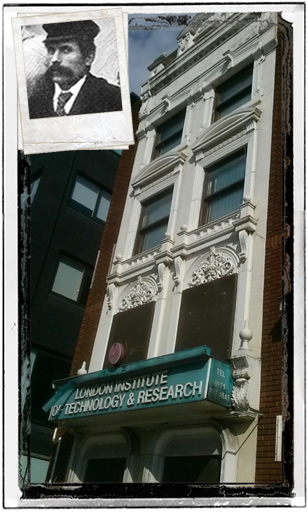
The Crown, Borough High Street
Born Severyn Anowicz Klosowski in Kolo, Poland, George Chapman was a notorious Victorian serial killer. Having lived previously in the East End and in the United States, by the late 1890s he was back in London, and lived in this building on Borough High Street. It was The Crown Pub at the time, and George was the landlord. .
In 1902 he was living here with 19-year old Maud Marsh, who was working for him, downstairs, as a barmaid at the time. Unbeknownst to Marsh, Chapman had an estranged wife, and had murdered his two previous mistresses by poisoning them to death. 39-year old Mary Spink had died on Christmas Day 1897, and Bessie Taylor on Valentine's Day, 1901. Upon both of these murders nobody had suspected foul play, and Chapman had simply gotten away with them.
On the 22nd of October 1902 his third murder took place here, when he poisoned Maud with tartar-emeric (antimony potassium tartrate). Police quickly considered her death suspicious, Chapman's former mistresses were exhumed, and it was discovered that he had poisoned them, too. His motives seemed a mystery - he had inherited a sum of money after one murder, but had seemingly gained nothing at all from the other two. it might appear that he killed them simply because he wanted to.
Chapman stood trial for Maud Marsh's death on March 19th, 1903 at the Old Bailey, and declared his innocence. Having heard the evidence presented, the jury retired for ten minutes, and upon their return declared him guilty. When asked if he could give any reason why a death sentence should not be passed, Chapman 'appeared in a dazed condition' and said nothing. He was sentenced to die by hanging, and was executed at Wandsworth Prison less than three weeks later, on the 7th of April. Upon his death, his estranged wife immediately remarried, and Chapman was described in the press as "one of the most undesirable aliens that ever invaded our hospitable shores."
Photo courtesy of John Chambers.
 Patricia Atkinson's Flat
Patricia Atkinson's Flat
On April 23rd, 1977, 'Yorkshire Ripper' Peter Sutcliffe was driving through Bradford's red light zone when he saw 32-year old Patricia Atkinson arguing with a driver in front of him. He pulled up beside her, and she got into the car. She told him that she had a place they could go to, and the pair drove to this flat on Oak Lane. Sutcliffe had a claw hammer beneath the driver's seat, and hid it in his coat as they left the car.
Once inside the flat, he hung his coat on the back of the door, and with her back turned, hit her four times in the head with the hammer. He dragged her onto the bed, pulled down her clothes to expose her, and stabbed her six times in the stomach with a knife. He then stabbed her in the back, and mutilated her with knife wounds along the left side of her body. He then covered her with the bedsheets, fled the scene, and would later state that she 'was still making a gurgling noise' as he left. Sutcliffe simply left her to die where he had attacked her. She was found the following evening by a friend who called at her flat. It was Sutcliffe's first murder indoors.
He discarded the hammer in nearby Cottingsley Bridge, where it was a found by a groundsman, who would unwittingly go on to use it for the next three years. In January 1981, he was found guilty of 13 murders, and was sentenced to spend at least 30 years in prison. In 2010, his sentenced was upgraded to a 'whole-life tariff', meaning that it is unlikely he will ever be released. He is currently held at Broadmoor Psychiatric Hospital.
Photo courtesy of Ricky Cobb.
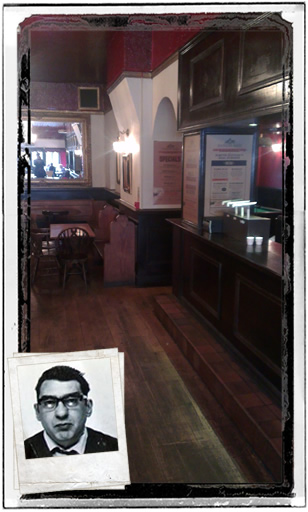 The Blind Beggar Pub, Whitechapel
The Blind Beggar Pub, Whitechapel
On the evening of the 9th March, 1966, George Cornell was murdered here (at the end of the bar, by the entrance into the arch) by East End gang boss Ronnie Kray.
Earlier in the evening Ronnie had been drinking with his brother, Reggie Kray, and other gang associates at the Red Lion pub on Tapp Street, when word reached him that Cornell, a member of the rival Richardsons gang, was at the Blind Beggar. Ronnie would later write that Cornell had previously called him 'a fat poof' in front of crime associates, and had basically signed his own death warrant by doing so.
Ronnie had his driver, 'Scotch Jack' Dickson drive him to Whitechapel Road, and entered the pub with associate Ian Barrie. Cornell was with two associates, and as Kray approached he was heard to say 'Well, look who's here.' The two with Cornell got up to leave. Kray produced a 9mm handgun from his pocket and shot Cornell in the head at close range,critically injuring him, and simply walked out again. The bullet hit him in the front of the head, exited through the back and hit the wall across the room behind him. Cornell died two hours later.
When questioned by police, nobody in the pub had seen anything. One 'old man', who had been sitting at the bar at the time, was asked why he was choosing to be uncooperative. "I don't like the sight of blood", he told them, "especially my own."
Over two years then passed before the Kray twins were arrested, and the pair went to trial in January 1969 for the murder of Cornell and for another murder; that of Jack 'The Hat' McVitie, that had taken place in October 1967. It was the longest and most expensive trial in British criminal history, and after deliberating for nearly seven hours the jury found the pair guilty. They were sentenced to serve thirty years each, with no possibility of parole.
Do you have a picture (that you've taken yourself) of a notorious crime scene from history? Send it to us and we might put it up here! (No gore!) Send your pics to hello@ripperworld.net.





